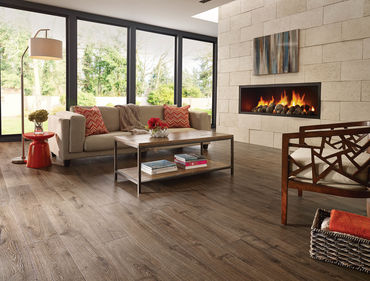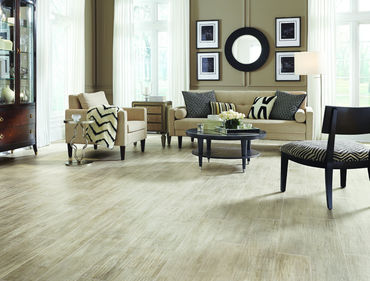Laminate flooring has a variety of environmentally friendly benefits, but one of them beats them all: Laminate flooring creates the look of a natural resource – such as wood or stone – as opposed to actually using it, so fewer raw materials are used in the manufacturing process. Because laminate flooring’s appearance is actually a high-definition photograph, it effectively provides the desired look, no matter how scarce, without felling a tree or mining a quarry.
That’s just one of the ways that laminate is the green choice in flooring, and eco-conscious consumers are sitting up and taking notice.
According to Bill Dearing, president of the North American Laminate Flooring Association (NALFA), “Laminate flooring has a wealth of green advantages, and products certified to NALFA’s sustainability standard are being used in growing numbers because of them. Consumers are becoming increasingly conscious of the importance of environmentally friendly products.”
Dearing says the NALFA Certification Seal is confirmation that a laminate floor is manufactured with these earth-friendly qualities:
- It’s made with recycled natural resources producing a heavy-duty, high-density core board.
- It’s recyclable.
- It’s free of air-damaging chemicals.
- It complies with formaldehyde emissions regulations for laminate flooring core board set forth by the California Air Resources Board (CARB).
- It is comprised of recycled content that may contribute points to the Leadership in Energy and Environmental Design (LEED) standards for homes and businesses.
- It requires no special glues or adhesives during installation, eliminating harmful volatile organic compounds (VOCs), and no special cleaners for cleaning and maintenance, improving air quality.
From the materials used in its manufacturing to the frequent reuse of those materials, a NALFA-certified laminate floor’s entire lifecycle is environmentally friendly. “For floors to be considered green, the manufacturing, installation, and disposal processes should have no negative environmental impact,” Dearing says.
Laminate flooring’s environmentally friendly properties begin with its inherently green manufacturing process. For example, the manufacture of laminate floors does not involve the harvesting of old-growth hardwoods. Product cores are comprised of at least 74 percent pre-consumer recycled waste, such as sawdust from mills and wood chips from log processing. This minimizes the need for new raw materials, whose harvesting often depletes natural resources.
In addition to its eco-friendly manufacturing process, laminate flooring is also installed with the environment in mind. NALFA-certified laminate floors are installed as floating floors, meaning the products are not attached to the subfloor. This eliminates the need for glues and adhesives, helping prevent emissions of volatile organic compounds.
Once installed, laminate floors can be easily cleaned without the use of harsh chemicals, protecting indoor air quality. Finally, at the end of a laminate floor’s lifetime, it can be reused or recycled. Or, when dismantled, the boards can be put back into the production process, ground for agriculture use, or burned as waste-to-energy. That keeps old flooring from landing in the landfill.
Laminate flooring is also an environmentally friendly consideration when a homeowner’s interest is a living area with fewer allergens. Laminate flooring is free of solvents, preservatives, and other chemicals that can agitate allergies and asthma.
With the ongoing evolution of laminate flooring, environmental issues will play an increasing role in the way the next generation of laminate products is developed.


